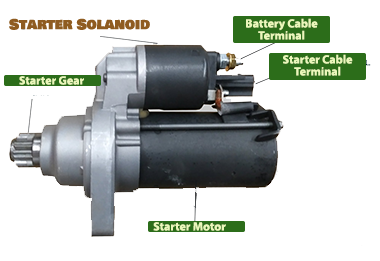 All solenoid valves require a regular cleaning. . When a valve is clean, the armature produces a slight metallic click. Excessive noise, sluggish functioning, or signs of fluid leakage indicate the need for cleaning.
All solenoid valves require a regular cleaning. . When a valve is clean, the armature produces a slight metallic click. Excessive noise, sluggish functioning, or signs of fluid leakage indicate the need for cleaning.
Solenoid valve maintenance typically consists of replacing rubber parts and springs. So, if the remaining parts are worn or broken, it is time to replace them. A solenoid valve's maintenance entails replacing worn components and keeping parts clean and free of contaminants.
 Many starters are located near the bottom of the engine, out of the way. Given the nature of gravity, any fluid leaks will eventually find their way to the bottom of the engine. A starter motor that has been saturated in coolant, oil, or other foreign bodies cannot function correctly.
Many starters are located near the bottom of the engine, out of the way. Given the nature of gravity, any fluid leaks will eventually find their way to the bottom of the engine. A starter motor that has been saturated in coolant, oil, or other foreign bodies cannot function correctly.
 If the starter does not operate in a clean environment for a long time, it will gradually cease to function. That is why it is important to locate the cause of the fluid leaks, correct them, and then carefully clean the starter and surrounding region.
If the starter does not operate in a clean environment for a long time, it will gradually cease to function. That is why it is important to locate the cause of the fluid leaks, correct them, and then carefully clean the starter and surrounding region.
The starter has only one job: to start the engine, although the significance of that one task cannot be understated; the vehicle will not turn a wheel if the engine didn't start. To function the starter simply requires a strong jolt of current every now and then.
 The first criteria is quite simple to meet. Check that the battery terminal clamps are clean and tight so that the battery can meet the starter's needs for large amounts of current.
The first criteria is quite simple to meet. Check that the battery terminal clamps are clean and tight so that the battery can meet the starter's needs for large amounts of current.
The electrical connections on the starter must also be clean and tight, and the heavy starter wire connecting the battery and starter must be in decent shape. If there are any junctions along the way, ensure that the connections are clean and tight.
The final stage in any solenoid and starter maintenance procedure is, with the help of a little brush, to apply a good layer of moly oil on the pinion on the starter. This is obvious sense; they are gears, just like any other, and will benefit from lubricating.
When everything has been cleaned up, test the starting/battery circuit to ensure that the starter has no permanent damage. Be prepared to replace the starter if it is in marginal condition and liable to cause problems soon.
Keep in mind that classic cars can have different requirements and limitations, so it might be worth checking the service manual for the specific make and model to see if there are any other steps you should take to maintain your starter motor.


Solenoids and starters are well known for their longevity- and in a restored classic that should many years in the future. If either of these important parts begin to show signs of malfunction or wear, an immediate visit to an auto-electrician is recommended- without too much dealy.
 It's important to note that, if the car is not used frequently, it's recommended to start the engine and let it run for a few minutes every month, to avoid the battery and starter from getting damaged or not performing to the maximum of its capability.
It's important to note that, if the car is not used frequently, it's recommended to start the engine and let it run for a few minutes every month, to avoid the battery and starter from getting damaged or not performing to the maximum of its capability.
br4





